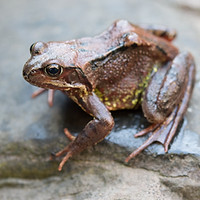
Outreach
One of my professional goals is to make science accessible to broad audiences. I hope to inspire others to appreciate the biodiversity on the planet, so I view public outreach as an essential part of my role as a scientist. Working in natural history museums has provided excellent opportunities to interact with the public and share fascinating aspects of biodiversity. I have also given public lectures and worked with science outreach programs for K-12 students and look forward to continuing these types of activities.
OSU Museum of Biological Diversity
Each Spring the OSU Museum of Biological Diversity hosts an Open House for the public. I volunteer in the Tetrapod Division getting exhibits ready and talking with visitors as they tour the collection. Thousands of visitors come to see the museum in one day! School groups also visit the museum throughout the year. Most recently, we hosted students from Fort Hayes High School who were working on a class project on biodiversity. We featured specimens to explain aspects of tetrapod evolution and Ohio wildlife.
Posters made for 2019 Open House highlighting the importance of tetrapod collections for studying environmental change
UNM Museum of Southwestern Biology and
New Mexico Museum of Natural History
While a postdoc at UNM, I volunteered at the annual Museum of Southwestern Biology (MSB) Open House and tabling events at the NM Museum of Natural History. I shared some of my ongoing research on avian blood parasites, displayed and answered questions about some of our most spectacular specimens, and created an MSB Birds “trivia” game -- Matching the Disney character to the specimen seemed to be a big hit!
FSU Coastal and Marine Laboratory
For two years during graduate school at Florida State University, I was an instructor for the Saturday-at-the-Sea program. We led field trips for middle school students to the FSU Coastal & Marine Laboratory, facilitating hands-on discoveries about coastal and marine biodiversity. Highlights always include trawling seagrass beds for invertebrates and fish, observing plankton under the microscope, and helping students make connections between the physical environment and the creatures living in different habitats (from oyster bed to salt marsh to sand bar).
I also gave a public lecture as part of the Conservation Lecture Series at the FSUCML, sharing some of my work on frogs and the role of genetics for informing conservation.




